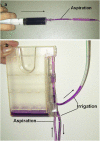Post-cataract endophthalmitis caused by multidrug-resistant Stenotrophomonas maltophilia: clinical features and risk factors
- PMID: 25618260
- PMCID: PMC4320429
- DOI: 10.1186/1471-2415-15-14
Post-cataract endophthalmitis caused by multidrug-resistant Stenotrophomonas maltophilia: clinical features and risk factors
Abstract
Background: To report clinical features and risk factors of post-cataract surgery endophthalmitis (PE) due to Stenotrophomonas maltophilia.
Methods: A retrospective case review from December 10, 2010 to April 7, 2011 was performed at the Eye & ENT Hospital, Fudan University. Data were collected for surgical details, disease characteristics, antibiotic sensitivity of the pathogen, and treatment response. Visual outcomes were examined with a minimum follow-up of 12 months.
Results: Fourteen cases of S. maltophilia endophthalmitis were identified. The onset of infection occurred from 1-56 days postoperatively (median, 13.5 days). Obvious cellular reactions were found in all patients in the anterior chamber, along with the absence of pupil synechia. Retinal periphlebitis was an early sign of PE. S. maltophilia was positive in eight patients (57.1%). The fluids from aspiration tubes revealed the same bacteria, which were resistant to multiple drugs (e.g., amino glycosides, most of the β-lactams, aztreonam, imipenem, and ciprofloxacin), except levofloxacin. Compared with the culture-negative group, the infection was more rapid, more severe, and more difficult to control in the culture-positive group. Among 14 patients, 11 patients (78.6%) underwent pars plana vitrectomy (PPV) with intravitreal injection. Three patients had PPV twice, and three patients had intraocular lens and capsular bag removal. A final visual acuity of ≥20/100 was achieved by 13/14 patients (92.9%). Complications included retinal detachment in three cases (21.4%) and recurrence of infection in two cases (14.8%). Statistical analysis showed that age over 90 years and posterior capsule rupture were risk factors of infection (P=0.034 and P=0.034, respectively). The phacoemulsifier allowed potential contamination between the aspiration and irrigation tubes.
Conclusions: S. maltophilia should be considered a pathogenic organism of PE. The infection often occurs in older patients with posterior capsule rupture. Intravitreal or systemic administration of effective antibiotics and earlier initial PPV may contribute to better clinical outcomes. Tubes with connections between aspiration and irrigation should be avoided during surgery.
Figures




Similar articles
-
Stenotrophomonas maltophilia: An emerging entity for cluster endophthalmitis.Indian J Ophthalmol. 2017 Nov;65(11):1166-1171. doi: 10.4103/ijo.IJO_314_17. Indian J Ophthalmol. 2017. PMID: 29133644 Free PMC article.
-
Stenotrophomonas maltophilia Endophthalmitis after cataract extraction.Ocul Immunol Inflamm. 2006 Feb;14(1):41-6. doi: 10.1080/09273940590950981. Ocul Immunol Inflamm. 2006. PMID: 16507490
-
Stenotrophomonas maltophilia induced post-cataract-surgery endophthalmitis: Outbreak investigation and clinical courses of 26 patients.Infection. 2009 Apr;37(2):117-22. doi: 10.1007/s15010-008-8150-8. Epub 2008 Dec 5. Infection. 2009. PMID: 19148575
-
[Endoscopy-guided 20-G vitrectomy in severe endophthalmitis: Report of 18 cases and literature review].J Fr Ophtalmol. 2015 Dec;38(10):941-9. doi: 10.1016/j.jfo.2015.07.005. Epub 2015 Nov 10. J Fr Ophtalmol. 2015. PMID: 26563835 Review. French.
-
Endogenous bacterial endophthalmitis: an east Asian experience and a reappraisal of a severe ocular affliction.Ophthalmology. 2000 Aug;107(8):1483-91. doi: 10.1016/s0161-6420(00)00216-5. Ophthalmology. 2000. PMID: 10919895 Review.
Cited by
-
Advances in the Microbiology of Stenotrophomonas maltophilia.Clin Microbiol Rev. 2021 Jun 16;34(3):e0003019. doi: 10.1128/CMR.00030-19. Epub 2021 May 26. Clin Microbiol Rev. 2021. PMID: 34043457 Free PMC article.
-
Atrophy of retinal inner layers is associated with poor vision after endophthalmitis: a spectral domain optical coherence tomography study.Eye (Lond). 2017 Oct;31(10):1488-1495. doi: 10.1038/eye.2017.100. Epub 2017 Jun 2. Eye (Lond). 2017. PMID: 28574491 Free PMC article.
-
Risk factors for endophthalmitis requiring evisceration or enucleation.Sci Rep. 2016 Jun 15;6:28100. doi: 10.1038/srep28100. Sci Rep. 2016. PMID: 27302573 Free PMC article.
-
Stenotrophomonas maltophilia: An emerging entity for cluster endophthalmitis.Indian J Ophthalmol. 2017 Nov;65(11):1166-1171. doi: 10.4103/ijo.IJO_314_17. Indian J Ophthalmol. 2017. PMID: 29133644 Free PMC article.
-
Bacterial profile of ocular infections: a systematic review.BMC Ophthalmol. 2017 Nov 25;17(1):212. doi: 10.1186/s12886-017-0612-2. BMC Ophthalmol. 2017. PMID: 29178851 Free PMC article.
References
Pre-publication history
-
- The pre-publication history for this paper can be accessed here:http://www.biomedcentral.com/1471-2415/15/14/prepub
Publication types
MeSH terms
Substances
LinkOut - more resources
Full Text Sources
Other Literature Sources
Medical
Research Materials
Miscellaneous

